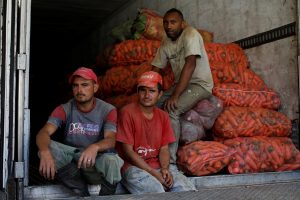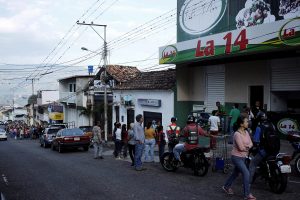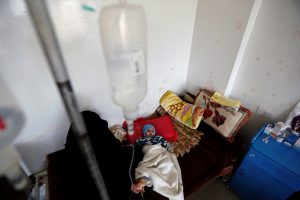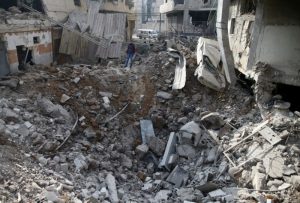
BEIRUT (Reuters) – Pro-government forces pounded Syria’s eastern Ghouta on Tuesday, killing at least 66 people after the enclave’s heaviest one-day death toll in three years, a monitoring group said.
Sparking an international outcry, the surge in air strikes, rocket fire, and shelling has killed more than 210 adults and children in the rebel pocket near Damascus since late on Sunday, the Syrian Observatory for Human Rights said.
France described the government bombing as a serious violation of international humanitarian law.
There was no immediate comment from the Syrian military. Damascus says it only targets militants.
Recent violence in the besieged suburb is part of a wider surge in fighting on several fronts as President Bashar al-Assad’s military pushes to end the seven-year rebellion against him.
A U.N. coordinator called for an immediate ceasefire on Monday and said that Ghouta was “spiraling out of control” after an “extreme escalation in hostilities”.
In Geneva, the U.N. children’s agency expressed outrage at the casualties among the enclave’s children, saying it had run out of words.
Those killed since the escalation began on Sunday include 54 children. Another 850 people have been injured, the Britain-based Observatory said.
In Brussels, Syrian opposition leader Nasr al-Hariri – a delegation head at stalled U.N. peace talks – told the European Union the intensified attacks consisted a “war crime”, and pleaded for more international pressure on Assad to stop.
WARPLANES IN THE SKY
Rescuers said the air raids create “a state of terror” among residents in eastern Ghouta, where the United Nations says nearly 400,000 people live. The pocket of satellite towns and farms, under government siege since 2013, is the last major rebel bastion near the capital.
Factions in Ghouta fired mortars at Damascus on Tuesday, killing six people and injuring 28, Syrian state TV said. The army retaliated and pounded militant targets, state news agency SANA said.
The Syrian foreign ministry said militants in Ghouta were targeting Damascus and using people there as “human shields”. It said in a letter of complaint to the U.N. that some Western officials were denying the government’s right to defend itself.
The Civil Defence in eastern Ghouta, a rescue service that operates in rebel territory, said jets battered Kafr Batna, Saqba, Hammouriyeh, and several other towns on Tuesday.
“The warplanes are not leaving the sky at all,” said Siraj Mahmoud, a civil defense spokesman in Ghouta, as the sound of explosions rang out in the background.
Mahmoud said that government forces bombed houses, schools and medical facilities, and that rescuers had found more than 100 people dead “in one day alone” on Monday.
Reuters photos showed bandaged people waiting at a medical point in the town of Douma, some of them with blood streaming down their faces and their skin caked in dust.
Bombs struck five hospitals in the enclave on Monday, said the UOSSM group of aid agencies that funds medical facilities in opposition parts of Syria.
DE-ESCALATION ZONES
Assad’s most powerful backer, Russia, has been pushing its own diplomatic track which resulted in establishing several “de-escalation zones” in rebel territory last year.
Fighting has raged on in eastern Ghouta even though it falls under the ceasefire plans that Moscow brokered with the help of Turkey and Iran. The truces do not cover a former al-Qaeda affiliate, which has a small presence in the besieged enclave.
Residents and aid workers say the “de-escalation” deals have brought no relief. Food, fuel, and medicine have dwindled.
The two main rebel factions in eastern Ghouta, which signed the deals with Russia last summer, accuse Damascus and Moscow of using the jihadist presence as a pretext for attacks.
Moscow did not comment on the renewed bombing in eastern Ghouta on Tuesday.
Russian Foreign Minister Sergei Lavrov blamed on Monday “armed provocations” by Nusra militants, formerly linked to al-Qaeda, for conditions in Ghouta. He said Moscow and its allies could “deploy our experience of freeing Aleppo … in the eastern Ghouta situation”.
U.N. Syria envoy Staffan de Mistura warned on Tuesday that the escalating battle in Ghouta could turn into a repeat of the bloody fight for Aleppo, which Damascus regained full control of in late 2016 after years of fighting.
“These fears seem to be well founded,” aid group International Rescue Committee also said on Tuesday. It said malnutrition was widespread and Ghouta’s schools had been closed since early January because of the attacks.
“The people of Eastern Ghouta are terrified… There is nowhere safe for them to run to,” IRC’s Middle East Regional Director Mark Schnellbaecher said.
(Reporting by Angus McDowall, Ellen Francis, and Lisa Barrington; additional reporting by Tom Miles in Geneva; editing by Andrew Roche)












